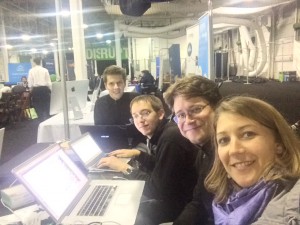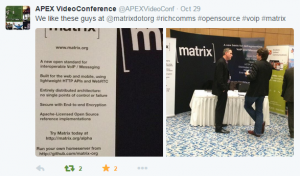Matrix has been showing off in various places these last months. But whilst drowning in the launch we haven't managed to keep the blog updated with what's been going on! We are now much more back on track and able to catch up at last, as well as start on new ground for upcoming events!
So you'll find here a summary of the 4 events Matrix attended in September and October as well as all the presentations we gave!
🔗Disrupt San Francisco (September 6-10)
![IMG_4849[1]](http://matrix.org/blog/wp-content/uploads/2014/11/IMG_48491-300x225.jpg)

Disrupt SF was the launchpad of Matrix! We participated in the Hackathon as both a sponsor and a competitor (see our live update!), and exhibited at the conference as a Product Sponsor.
Three teams announced that they were using Matrix to build their hack but eventually only Go Social presented their project: a social network for travelers with a very nice UI! Go Social used Matrix APIs to add chat to their platform. The video of Go Social's presentation is here.
Matrix team worked on Animatrix: a chat app allowing you to build your own 3D animated cartoon and share it with any other friend using Matrix-compliant app using Unify. We had to hack together a basic Matrix Android client in order to do the demo .... You can see our project's presentation here!
![IMG_4858[1]](http://matrix.org/blog/wp-content/uploads/2014/11/IMG_48581-300x225.jpg)
The three days conference was great in terms of reaching out to devs and getting good feedback on Matrix! We love seeing people's eyes lighting up and people saying "Eventually someone is doing it!" when we explain what Matrix is about :) So thank you all for your support!
🔗Disrupt Europe (London, UK - October 18-21)
After getting public in SF, Disrupt London was the next steps to release a more stable version of Matrix and encourage even more people to build on Matrix. Again we sponsored both the Hackathon and the Conference and we brought with us a very cool PhantomX robot from Trossen Robotics which was also the price we gave away during the hackathon.
![IMG_5019[1]](http://matrix.org/blog/wp-content/uploads/2014/11/IMG_50191-300x225.jpg)
Two teams pitched a Matrix project at the Hackathon this time:
Hujambo is a very cool chat app allowing you to chat in your native language to someone who is going to read you in their own native language.
Movidiam did a very ambitious hack, modelling the trends of conversation in the Matrix ecosystem and displaying them a force-directed graph visualisation using D3.
Matrix team worked on a MIDI to Matrix bridge allowing to share and display music you play in a chatroom and jam together even if in different places. Here is the demo video:
http://youtu.be/LXDBoHyjmtw
Another great time to meet a lot of interesting people and build partnerships!
🔗WebRTC Summit Europe and Rich Communication Conference (Berlin - October 27-29)
Matrix was a Silver sponsor at WebRTC Summit and the Rich Communication events and it was a great opportunity to show the multiple ways that Matrix can be considered.
The first day was the WebRTC Summit where the focus was on the challenges and next steps of the standard. Matthew presented Matrix explained how it can be used as the missing signaling layer to WebRTC raising lots of questions and interest. You can see the presentation here.

The two next days were focusing more on Rich Communication Services (RCS) and again Matrix didn't go unnoticed, and not only because of the lightspeed presentation from Matthew waking everyone up on Wednesday morning! This time Matthew addressed Telcos and RCS vendors with the compelling proposition of using Matrix as the bridge between RCS/IMS/PSTN and the world of over-the-top applications. The presentation is downloadable here.
Again some great feedback and lots of animated discussions over the future of the IP communication world!


🔗WebRTC Summit (Santa Clara - November 4-5)
Beginning of November Matrix was back on the West Coast to sponsor the WebRTC Summit, collocated with the CloudExpo. Matthew opened the WebRTC track with another presentation again raising a lot of interest and question, and greatly supported by Hookflash in their following session. The presentation is available here.
And the tour continues: this week Matrix sponsored the TADSummit in Istanbul and next week we will be in San José at the WebRTC World Conference & Expo: meet us there and watch out for the upcoming TADSummit news!



![IMG_4849[1]](http://matrix.org/blog/wp-content/uploads/2014/11/IMG_48491-300x225.jpg)

![IMG_4858[1]](http://matrix.org/blog/wp-content/uploads/2014/11/IMG_48581-300x225.jpg)
![IMG_5019[1]](http://matrix.org/blog/wp-content/uploads/2014/11/IMG_50191-300x225.jpg)


